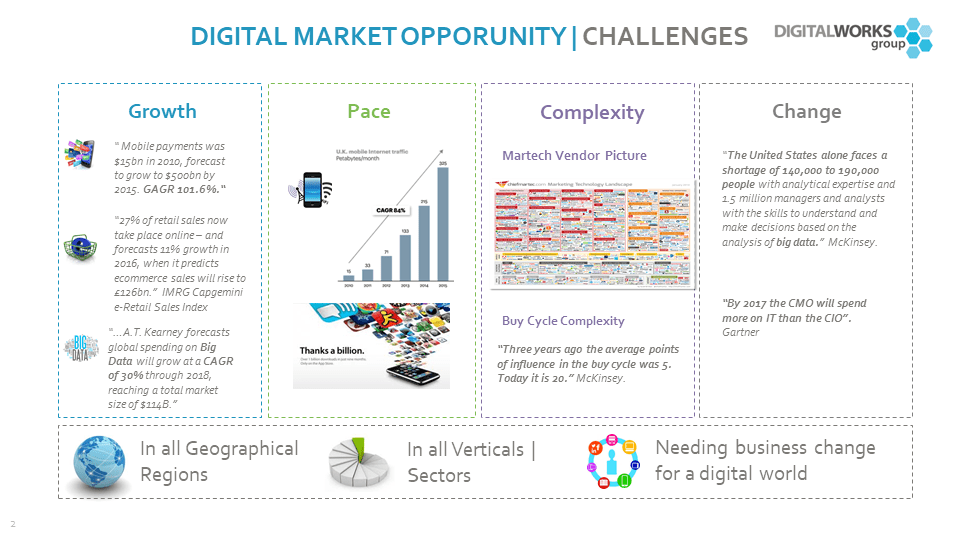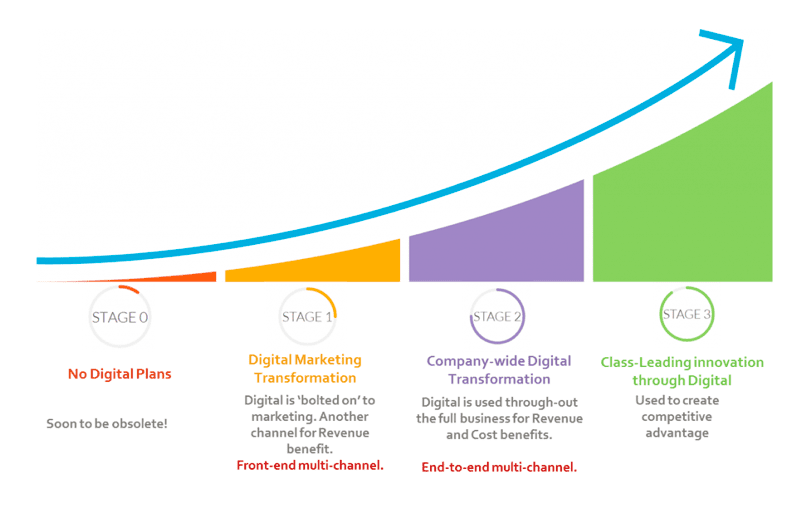The ‘digital’ opportunity is enormous, with staggering growth in all territories and sectors
Along with the opportunities come some significant challenges as you adapt to highly demanding digitally-savvy customers.
These challenges are caused by the pace, complexity and the degree of change. 
This shifting environment means that digitally-led business transformation is a complex and on-going journey - an evolution to transition and optimise your business.
Even digitally native companies know that they have to innovate and stay ahead of the game because of growing disruption and rapid technological change.
Download our Business Resource – Managing Digital Transformation Guide
Create a roadmap to implement digital transformation - This practical guide was created to support marketers throughout the digital transformation process. It's clearly structured in seven sections to step you through the process of initiating and running a digital transformation programme.
Access the Managing digital transformation guide
Smart Insights members can also use the free digital benchmarking templates and interactive capability graders to assess their digital evolution.
Understanding your starting point and direction of travel
Before embarking on any digital change programme, it is essential to have a clear understanding where your starting point is and the direction you need to travel.
- What is your starting point?
- Why are you trying to transform digitally?
- What is your priority?
- What is your measurement of success?
Without this, you could be contemplating an expensive, potentially highly disruptive and business-wide change programme without setting a clear vision and well thought-out strategy and objectives.
The digital evolution curve: simplifying the complex
At Digital Works Group we explain how any organisation can digitally optimise itself to develop competitive advantage via a simple ‘digital evolution curve’.
This tried and tested graphic was developed because our clients needed a simple and clear illustration of what the typical digital transformation journey might look like.
The graphic makes it easy to plot the trajectory a business can make over time, irrespective of industry, size or maturity.
Most importantly it illustrates how businesses can move up the digital curve to maintain competitiveness and thrive in the face of disruptive innovation, increasing competition and rapidly changing consumer behaviour.
So let’s dive in.

“Approximately 90% of CEOs know that digital technology is impacting their industry, but less than 15% are digitally transforming with a clear plan.”
The curve explained
Stage 0: No digital plans
This is far more common than you think!
We estimate that over 50% of businesses do not have a comprehensive plan for embracing digital technology.
Most businesses are doing something, but it is likely to be uncoordinated and not linked directly to the long-term plans for the business. If businesses do not fix this, they will become obsolete sooner or later.
Stage 1. Digital Marketing Transformation
Digital marketing transformation can be done as a distinct project, and rapidly deliver revenue benefits. Done well, this can increase confidence and kick-start your wider digital transformation.
This stage deals with what we would term as micro transformation.
Digital is initially bolted on to the marketing function to transform the way a company engages with the outside world (and staff/partners too) to deliver a front-end multi-channel experience. Key elements include:
- Multichannel communications improve acquisition and retention
- Responsive digital assets increase conversion
- Data Analytics is driving marketing performance
- Integrated digital enhances competitiveness
- Best in class platforms support marketing effectiveness and speed
A typical business at this stage: may have a strong web presence and analytics supporting the customer experience. It is about revenue generation and top-line benefit.
Often a stage 1 organization has legacy core systems and logistics; finance, reporting, operations, and HR are often on separate older systems. Processes frequently incorporate people and transfers of files etc.
Things to consider: How does the culture of your organization tick? How will digital channels and processes be adopted across audiences, e.g. Staff, customers, and suppliers? Digital is another channel, not the only channel.
Clear benefits: This is often a good way to get started on the digital journey, allowing an organization to commit to customer-facing enhancements.
Stage 2. Company-wide transformation
Stage 2 provides a more macro-transformation.
We typically may see a business who has already enhanced their marketing and front-end digital experience, delivering a multichannel experience in the front-end, but are now ready to embark on company-wide transformation. Key elements include:
- Multichannel customer experience improves satisfaction and engagement
- IT and operational enhancements increase efficiencies and lower costs
- Data insights improve strategic decision making and enhance business performance
- A digitally ready business is adaptable and drives growth through integrated e-commerce, martech, and HR
- Top and bottom-line benefits
A typical business at this stage: May have multiple large technology programmes in flight. It will be focusing on standardizing the common processes and implementing the new policy and risk frameworks. The business will be focusing on costs, efficiency, speed and simplicity.
Things to consider: The business will need to be very clear about the outcomes they want to see, the KPI’s and targets.
This stage is technically the most complex (and some argue boring), but it is essential to bring the wide-ranging benefits of digitization.
Clear benefits: This stage brings simplicity and cost saving (margin growth). It often leads to scale too.
Stage 3. Class-leading industry and business innovation
Stage 3 is where all the new stuff happens.
Lots of new disruptive businesses start here, building new/simplified ways to do mundane or complex tasks.
The activities seen gain traction quickly and disintermediate complex existing process or embrace new technology to deliver transformational customer experience. Some examples include:
- Enabling new types of CREATIVITY AND INNOVATION where Digital is at your business’s heart, not just a buzzword
- Driving business model change and new solution innovation
- Delivering game-changing competitiveness and its disruptive benefits
- Industry & business model benefit
Typical business activities in this stage: Are pilots, trials and new ventures. They may have set up a shadow IT team. Building new solutions in parallel which ultimately take the lead.
Things to consider: These activities can be expensive and must be tracked and constantly measured to ensure they are value for money.
Businesses must be prepared to get it wrong (fail) and forget about it. Expect to run lots of innovation trials in parallel. Everyone needs to be involved in making this transformation a success so don’t hide it away.
Clear benefits: This stage brings change quickest. It is disruptive when done effectively to both the business and competitors.
How you can start to move up the digital curve
1. Find out how digitally enabled your business is right now
Before you start to look at a long-term digital strategy (especially if you are at stage 0 or moving into stage 1), you should develop a good understanding how digitally enabled your business is compared to best practice.
Why?
This helps you gain clarity on how big the task is. Transformation can be complex and involve significant investments regarding time and resources. You need to be confident you know what you need to do to be truly competitive and maximize your digital investments.
A digital audit can help provide a clear understanding of how the business compares to digital best practice.
Typically a digital audit will employ a highly structured evaluation process to gain end-to-end insight into how digitally optimized the business is. This, in turn, will enable you to achieve top-level recommendations on what, where, and how to digitally transform.
2. Set a clear vision of what your long-term business goals are and how you are going to achieve them
Set a clear vision of what your long-term business goals are and how you are going to achieve them.
At the heart of any successful business is a laser-focus on objectives and strategy.
You must understand what you are trying to achieve. This means developing a strategic vision of what you want to look like and identifying the critical success factors that are needed.
This strategy should be based on the right insights and analysis. Your company vision needs to be agreed and shared across the business.
3. Create a clear framework for change
Once you have set your vision, this should work hand in glove with an actionable long-term plan. Creating a framework for delivering change.
Execution should be measured and tracked centrally so you can follow the performance of your digital transformation.
There needs to be stakeholder-focused metrics and deliverables, and collective responsibility in the senior executive for delivering digital transformation.
4. Finally, get communication and engagement going in your organization for digital transformation to work
It sounds simple, but for change to happen, it should not be done in silos.
There should be a collaborative environment and creation process where people across the organization to work together and have a consistent conversation.
Everyone needs to an understanding of what you want your vision to be and how it will change your organization. You need to understand the size of the challenge and what it is going to take to make the change happen.
Thanks to Richard Morecroft for sharing his knowledge in this post. Richard is a Senior Partner, Strategy and Leadership at
Digital Works Group Richard is a digital transformation expert with over 25 years experience delivering successful digital transformation, innovation and change in corporate and new venture environments.










